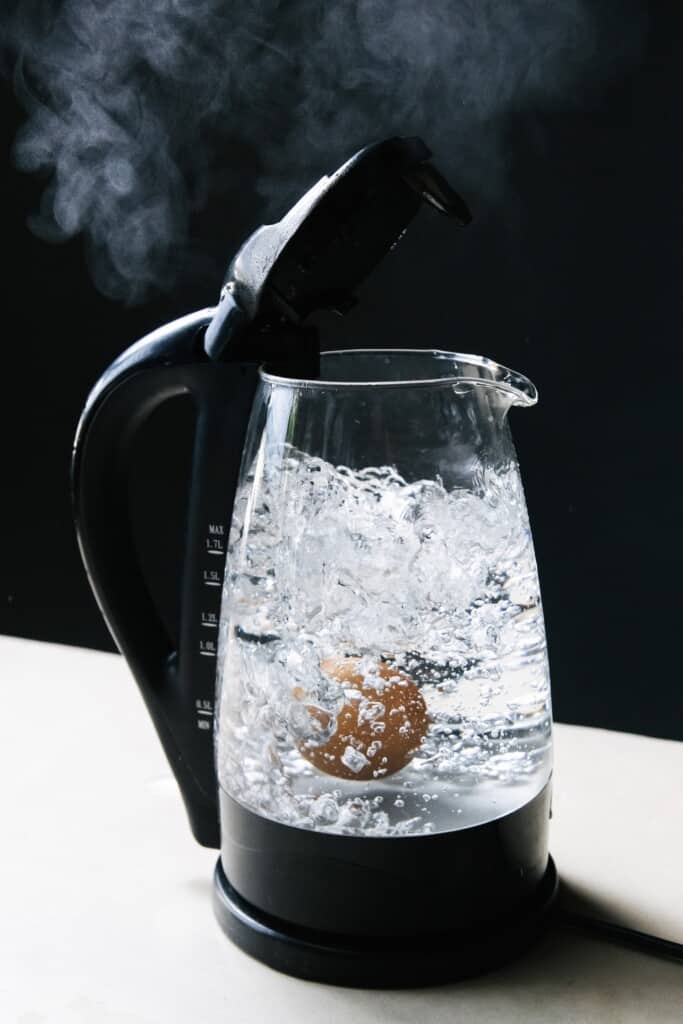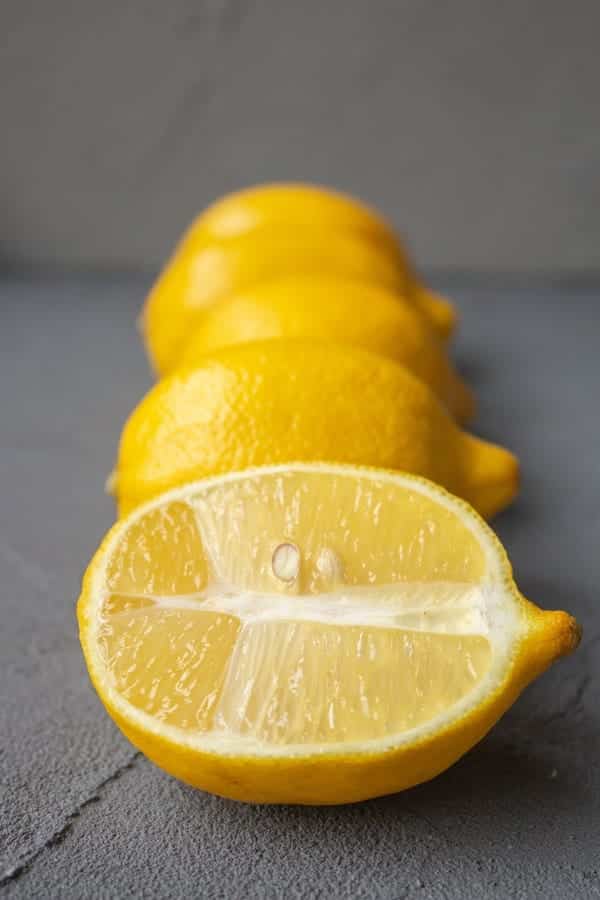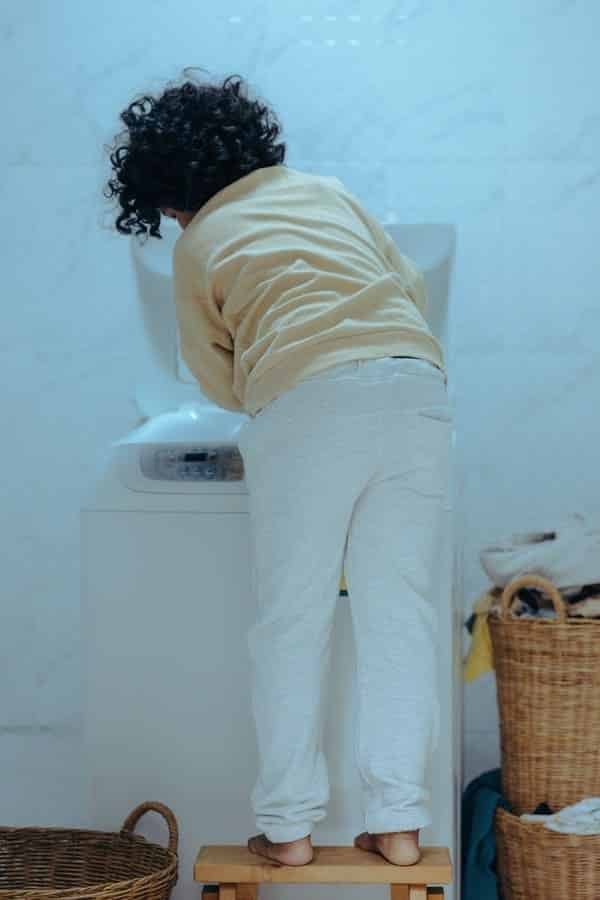Blueberries are delicious, sweet, full of antioxidants… and are notorious for staining! That’s why it’s so important to know how to remove blueberry stains out of clothes as soon as you see them.
Blueberry juice is hard to get out of clothing or fabric, and often, even a long, high-temperature cycle in the washing machine won’t fully budge it. So, without further ado, this article shows you ten effective ways to remove blueberry stains out of clothes.
There may be affiliate links in this article. You can read more about this in my disclosure.
Why Are Blueberry Stains So Bad?
While the color of blueberries is strong, the reason that they create tough stains on clothing and teeth is because of the high degree of natural sugars and the acidity of the fruit.
Blueberries contain a compound called anthocyanin, which gives them their powerful purple/dark blue color.
10 Effective Ways to Remove Blueberry Stains from Clothing
Boiling Water

Boiling water is one of the best procedures for fresh blueberry stains (and you need to act quickly). However, this must be only advised on robust fabrics, such as durable cotton.
Any material not recommended for hot water – or should be dry-cleaned only – shouldn’t come into contact with boiling water.
If the garment in question is good to go with the hot water immersion – here’s what to do:
- Bring a large pot of water to a boil. While waiting, get a clean white cloth and carefully dab it on the berry stain. Don’t wipe or press forcefully into the garment; this will cause it to bleed out and spread further into the textiles.
- Turn the berry-stained item inside out so you can immerse the stain properly. Doing this helps prevent the stain from penetrating deeper into the fabric.
- Place the stained items, stain-side down, over a large bowl and fasten it with a rubber band or string. Put the bowl in a bathtub or sink to help prevent splashing and catch any spillage.
- Hold the pot of hot water above the sink as high as possible. Pour a constant stream of boiling water to flush out the stain. Continue flushing until the stain is completely gone.
- Hang the garment outside in direct sunlight.
Lemon

Lemons are a long-standing and effective way of removing blueberry stains out of clothes such as white shirts or light clothes. This is because of their acidic content and “bleach-like” properties. Again – this stain removal method is generally only effective if you act quickly.
Older blueberry stains may be hard to remove and require a stronger method.
But if your stain is fresh – here’s what to do:
- Blot out the blueberry juice from your garment using a clean, damp cloth. Make sure to blot as much as possible.
- Turn the garment inside-out and rinse the back part of the stained area with cool water.
- Rub a fresh lemon slice over the discoloration several times. Rub the lemon gently to saturate the stain.
- Allow it to sit for about 5-10 minutes. Don’t wait until the lemon juice dries on the garment since the acid in lemons can damage textile fibers.
- If the garment is colored, keep it away from the sun while the lemon penetrates to prevent the fabric color from lightening.
- Apply detergent to the area and scrub gently for a few minutes.
- Rinse the garment at the manufacturer’s recommended water temperature indicated on the care label.
- Repeat steps 1-4 for stubborn stains until the discoloration is no longer visible.
- Hang and dry the garment in the sun.
Enzymes
This is one of the best acidic-based treatments for removing blueberry stains out of clothes. Here’s how to go about it:
- Fill a spray bottle halfway with the enzyme-based stain remover solution and spray it on the affected area. Wait for about 15 minutes for the solution to soak. Any less time and the method may not be successful.
- Wash your cloth with standard laundry detergent once no apparent stains remain. If your garments are white, use warm water; if they are colored, use cold water. To avoid spoiling the cloth, pay attention to the tags.
- Launder your garment as usual and dry it outdoors.
[amazon box=”B00J2L9EHS,B00HTNUKOM” grid=”2″]
Liquid Laundry Detergent
If the stain isn’t too deep or is on darker clothing, you should be able to remove it with standard laundry detergent on a high-heat wash. Here’s what to do:
- Wash your clothes in running water to lighten the discoloration.
- Directly apply the liquid detergent to the affected areas. Soak the stained garments for about 15 to 30 minutes in cold water, depending on the severity of the stains.
- Check for any remaining stains after soaking. Scrub any remaining stains with a soft brush if necessary.
- Rinse your clothes with cold water once you’ve removed all the spots.
- Wash as you usually do.
[amazon box=”B00HTNUKOM” template=”vertical”]
Hot Milk
Yes, you read that correctly! Hot milk is a surprisingly effective way to remove blueberry stains out of clothes. Here’s what to do:
- Gently warm up some milk in a pan. Don’t boil
- Pour the milk into the discolored area.
- Allow the milk to soak for 20–30 minutes.
- Blot the spots using a brush or clean cloth and lukewarm water.
- Wash as you normally would.
Baking Powder
Baking soda on stains has been a popular and reliable method for decades. This method can work particularly well with removing blueberry stains out of clothes. Here’s what to do:
- Put 4 tablespoons of baking powder and 1-2 tablespoons of lukewarm water over the stain.
- Allow 10–20 minutes for everything to soak. The powder should start to dissolve and froth.
- Blot out the stain by dabbing in a sponge while gently pouring lukewarm water.
[amazon box=”B074H7CBXJ” template=”vertical”]
Glycerine
If you’ve exhausted the above methods and still see a blueberry hint on your garment, glycerine may do the trick. Combine your glycerine with corn starch and an essential oil, such as eucalyptus, to make the smell more pleasant.
Here’s what to do:
- Apply glycerin on the berry stain just enough to cover the affected area.
- Leave the garment for half an hour for the glycerin to absorb.
- Rinse the garment and hang it outside to dry.
- If the stain persists after drying the garment, combine 1 teaspoon of glycerin, 2 drops of eucalyptus essential oil, and 1 tablespoon of cornstarch into a thick paste.
- Dab the glycerin paste on the stain and allow it to dry in the sunlight.
- Once the paste has dried, rinse it away.
- If there are still noticeable stains, apply glycerin paste repeatedly until the discoloration is entirely gone.
- Wash again as normal.
[amazon box=”B01N10L227″ template=”vertical”]
Oxygen Bleach
This is often the go-to last resort for particularly stubborn blueberry stains. This method needs to have a high concentration for it to be effective, so be mindful of the type of fabric you’re applying it to, as bleach is notoriously corrosive.
Here’s what to do:
- Test the bleach on an inconspicuous area of the discolored garment first (or a similar type of fabric).
- Use a clean, wet cloth and wipe it carefully on the discolored area. Doing this allows the stains to loosen a little bit.
- When the stain has lightened, launder your garment. If you wish to wash your garments by hand, make a solution of oxygenated bleach and cold water.
- All you need to do is combine equal parts of oxygenated bleach and water. Dilute it well to weaken the strong bleach properties that can discolor the fabric. Allow 1-2 minutes for the solution to soak into the discoloration.
- If you opt to machine wash your garments, pour the recommended bleach amount into the bleach dispenser and not directly into the garments. Wait for the washing cycle to finish.
- Rinse the stained garment with cold running water.
- If the stains are still apparent, repeat the procedure.
- Allow your garments to air dry if there are no lingering stains anymore.
[amazon box=”B005GI8UOO” template=”vertical”]
Stain Removal Products
If you’ve exhausted all of the above methods to remove blueberry stains out of clothes to no avail but are not ready to admit defeat yet, your best bet is to seek advice from a laundry or dry-cleaning expert on an effective stain-removal product for the garment in question.
Most of the above methods are courtesy of domestic products that aren’t explicitly designed for heavily stained fabric, so if the stain is particularly deep or isn’t fresh, you may need to invest in a product specially designed for the job.
Always follow the product’s packaging instructions for safe and effective results.
[amazon box=”B00JIRB0FU” template=”vertical”]
Denatured Alcohol
This method to remove blueberry stains out of clothes should be a last resort as it comes with a few risks. In particular, damage to the article of clothing, as well as causing color/dye bleeding.
So approach cautiously, and only if the other methods you’ve tried haven’t worked. Here’s what to do:
- Using gloves, dip a cloth in denatured alcohol and dab directly onto the stain, being mindful not to soak any other areas of the clothing.
- Don’t let the alcohol stay on your clothes for too long – just long enough for it to saturate and absorb the alcohol.
- Rinse and wash the garment as usual at a medium temperature.
[amazon box=”B07NFSFBXQ” template=”vertical”]
Conclusion
So, there you have it – ten proven techniques for effectively removing blueberry stains out of clothes.
Blueberries are notorious for staining due to a color compound found within the fruit called anthocyanin and their sugar and citric acid content. These leave a dark bluey-purple stain on clothing when spilled.
For the most best results, blueberry stains are best approached immediately. The longer the stain is left within the fabric‘s fibers, the harder it will be to remove.
Many of these techniques are subjective to the type of material that holds the stain, and many of them shouldn’t be applied to delicate fabrics, as they are corrosive and could cause the fabric to erode where the method is used.

All toxic chemicals, such as bleach, glycerine, and alcohol, should be handled carefully and kept out of the reach of children and pets. PPE is often recommended to prevent burns to the skin or irritation.
These methods should not be applied to fabric that is dry-clean only.
If you’ve exhausted all the above methods and still see some staining from the blueberry, seek advice from a professional cleaner such as a laundry expert or dry cleaner.
FAQS About How To Remove Blueberry Stains Out Of Clothes
Does OxiClean remove blueberry stains?
I’ve had good luck using OxiClean on blueberry stains. That stuff can get out all kinds of tough stains. Just be sure to follow the directions on the bottle and test it on a small spot first to make sure it’s colorfast. But yeah, it should definitely help with those pesky blueberry stains.
Do you use hot or cold water for berry stains?
For fresh berry stains, it’s best to start with cold water. Hot water can set the stain. After you’ve tried cold water, then feel free to switch to warm or hot water with a stain remover if needed. The key is to act fast before the berry stain has a chance to set.
Will Shout remove blueberry stains?
Shout is pretty effective at removing food stains like blueberries. Just spray it on ASAP and let it sit for a bit before throwing the item in the wash. It may take a little extra effort if the stain has already set, but Shout is definitely worth trying on blueberry stains.
Does vinegar stain clothes?
You know, vinegar is usually fine for washing most fabrics. But it couldn’t hurt to test a tiny spot first since it can lighten some fabrics over time. As long as you dilute it and don’t soak the clothes, vinegar is a pretty safe bet for getting rid of stains without damaging clothes.
How do you clean blueberries with baking soda?
Here’s a good trick – put about a teaspoon of baking soda in a bowl of water, add the blueberries, swish them around, and rinse thoroughly. The baking soda helps get rid of any residues and keeps the berries nice and fresh. Just a simple way to clean blueberries using stuff you probably have in your pantry.



